What is the first thing to consider when choosing the right size tent for camping? Camping offers an excellent opportunity to reconnect with nature and break from the daily grind.
But for comfortable camping, Choosing the right size tent is necessary to ensure an enjoyable experience outdoors. For those new to camping, the vast array of tent options, each with unique features, can be confusing. So, it’s essential to consider your specific needs to make the best choice.
Many people overlook the importance of choosing the right tent size when planning a camping trip. However, the size of your tent can significantly impact the success of your journey.
This guide will help you choose the right tent size for your camping needs. Additionally, it offers tips on selecting the best materials and features to look for in a tent, ensuring that your outdoor adventure is as enjoyable and stress-free as possible.
Choosing the Right Size Tent- Take First Step
One can easily determine the appropriate size of a tent. Start by looking at how much space an average person needs.
Now, let us take sleeping bags as an illustration. They have an estimated width of 60 centimetres. Multiply this by the number of people you expect to accommodate, and you will know the required floor area. Also, consider the apex height of the tent.
For instance, smaller tents (2-3 people) may range in peak height from 120 cm to 125 cm. It may allow for children to stand up but adults will usually need to stoop inside it as most parts of the tent will be shorter than its full height.
Key Factors to consider When choosing the right size tent
When choosing the right size tent for your camping adventure, evaluating several vital factors is crucial to ensure a comfortable and enjoyable experience. Consider tent size, material quality, and seasonal ratings to find the perfect match for your needs.
1-Space and Comfort
This is probably the most essential thing to many campers. When camping near your vehicle, weight and packed size matter less so larger tents are generally better options.
If the weather changes dramatically on you, then you would most likely reschedule your trip altogether. Also, you would bring additional creature comforts like your favourite cooler, candy bar, camping chair, blanket, portable grill, slackline, or fishing gear.
If it fits in your vehicle, it can be part of your camping experience. The same goes for your tent. Think about what comfort means to you as you read through the reviews.
Some people prefer their cozy tight little shelters while others will go for open tents with an awning out front. Make sure that your tent matches with your needs and style.
We evaluate space and comfort by looking at the overall use of space, vestibule space, pockets/clips/storage, height/headroom, how many beds fit inside & what sizes they are.
2-Overall Use of Space
The phrase “use of space” talks more than just size when referring to a tent; this is why we use it in our discussions on its size, too. It should be comfortable and feel spacious when inside due to this design aspect alone.
The angle of walls, something as simple as angles, can make a big tent feel small or a small one feel big enough to sleep in comfortably. We compare the interior size versus the exterior footprint dimensions, which gives you a clearer idea of what living in your tent will be like.
Most tents are cramped at their rated capacity, so if extra room is needed for playing board games such as Cribbage, spreading out baseball cards, or doing yoga, go for a tent of higher capacity than your group size.
Features like vestibule size and shape, headroom, as well as door and window placement can also help you determine if the tent is tall enough for all occupants and allows activities such as staring at the sky at night.
3-Vestibule Space
Think about your tent’s comfort in terms of the vestibule. This is a front or back porch to us. You can keep things like wet shoes, backpacks, etc., in here, and even larger items such as coolers or bikes.
That way, they are accessible but outside the main tent area, away from rain. Bigger vestibules make tents feel spacious and allow cooking during storms, too.
4-Pockets/Clips/Storage
Your tent’s storage options can significantly affect its comfort level. It is convenient to have pockets for things like phones, wallets, watches & glasses where these small valuables are kept safe but within reach when needed, anywhere we want them to be kept on our bodies.
Among other things we take into consideration are The number of pockets there are, their locations & sizes, plus anything else special like clotheslines (elevated cords) that could hold something off-ground feet or removable/adjustable ones so that you may configure your storage preferences accordingly by having it all hung up on one side instead of another.
5-Headroom
A camping tent’s headroom can make a big difference in how enjoyable living is, especially for taller people, so you can stand upright or turn around without straining your neck and back.
For smaller backpacking tents, standing up is a luxury; in larger car camping tents it becomes an advantage. In addition, the angle or pitch of a tent’s walls determines how roomy it feels. Sometimes, only the middle section of some tents allows standing, while others have enough space to dance for two people.
6-Bed Space
Camping has come a long way, with airbeds being standard features to most tents over the past 20 years because they are affordable and provide extra comfort, particularly to those with back problems.
For instance, if you use twin air mattresses and each one takes two sleeping spots, then when selecting your tent size, think about this. Usually, a four-person tent will accommodate two twin air beds.
7-Comfort is subjective
Everyone puts different weightings on their priorities for tent features. This necessitates an all-encompassing review of individual tents that figures out what is excellent and poor as well as anything between that enables users to choose the most important things to them.
8-Weather Resistance
Anyone who goes camping knows that weather can shift pretty fast, even on the hottest day; there might be chilly or windy nights in such weather conditions. Night skies may change from clear to stormy within moments.
Moreover, getting ready for various environments is as crucial as having appropriate clothes. Poor ventilation in hot weather can be as uncomfortable as a wet sleeping bag.
9-Durability
If you are going for just one week or you want to find a long-lasting companion for camping, then the durability of the tent is crucial. Some companies utilize inferior quality materials and stitching to cut costs which may be suitable for occasional campers or mild climates.
However, owning a sturdy tent is inevitable if you are a regular camper who mostly goes to rougher terrains.
Conversely, an expensive tent may be taken advantage of such that it costs many replacements in contrast with a high-quality unit that has served well throughout successive years.
When considering durability, it is essential to focus on the tent body’s material, rainfly, poles, and stakes.
The poles are especially important; broken poles can ruin your trip, so have backup fiberglass poles handy. Stakes and guy lines can quickly and inexpensively be replaced, but poorly made tent bodies will always need patching until they are no longer mendable.
Look for tight, clean stitching, taped or sealed seams, strong reinforced zippers, and rain flies that fit well. Most modern tents do not have footprints; hence, one should buy one or use tarps to increase their lifespan. You should check the return policy to ensure you can replace it or get a refund in case of any defects.
10-Family Friendly
Family friendliness refers to all the previous aspects as mentioned earlier but this kind encompasses a focus on accommodations for groups that include children, dogs and friends. Ensure it can sleep the entire group comfortably with their mattresses and ample storage options.
For sanitary purposes, there shall be spacious vestibules at the entrance to the main tent.
Consider how everyone will feel inside when it is storming outside. Cooking in the vestibule can make you eat while seated on bags without worrying about spilling them.
11-Looking at privacy
Is it more like an open mesh or a tent which provides enough cover during changing? Several rooms may be useful if you have brothers and sisters; besides, there must be a heavy floor for those people who keep pets while camping; in case your pet scratches doors then you should see what they are made of.
For more advice visit our guides on camping with pets
From tips to tiller, this tent packs just enough of what you need in an inexpensive package.
When dealing with families having different requirements, more giant tents seem to be better off overall due to their many extra features. Particularly, a large vestibule makes for a more functional and comfortable living environment inside your shelter for everybody.
12-Roominess
Floor space available per person. However, it should be noted that in the case of “A” or wedge-type tents, the flooring may be well-spaced, but most of the area cannot be used due to its slanting walls. Ideally, tent walls should be nearly vertical to maximize living space while staying away from a tent with a centre pole because it takes up space.
13-Portability
Tents that have large poles or aluminum frames may be difficult to pack and transport especially when you have a small car.
14-Compactness
How easily can the tent be folded into a smaller shape when it is not being used? Quick Setup: This is vital for rapidly setting up, especially if an individual comes late at night after being tired upon arrival at the campsite during rain time.
15-Ventilation and Protection from Insects:
Sewn-in floor, full-size entrance, window for cross ventilation, and net screening on all openings will keep out insects. When the weather turns bad, closing with zippers is more convenient. The canopy adds shade against the sun or protection against rain.
Rain Repellent Cloth:
Quality tents are treated to repel rain. Yet water-soaked walls touching some object or person during rainfall might leak due to capillary action.
Mildew Proofing:
Mold-proofing agents should always coat the tents, as they can spoil over time due to mildew growth, which can destroy them even if stored properly. However, one must store them dry, preventing mildew, too.
What Sizes Do Tents Come In?
Tents come in various sizes and shapes so that one can always find one which suits his/her needs best. Here are some popular tent sizes available:
One Man Tent
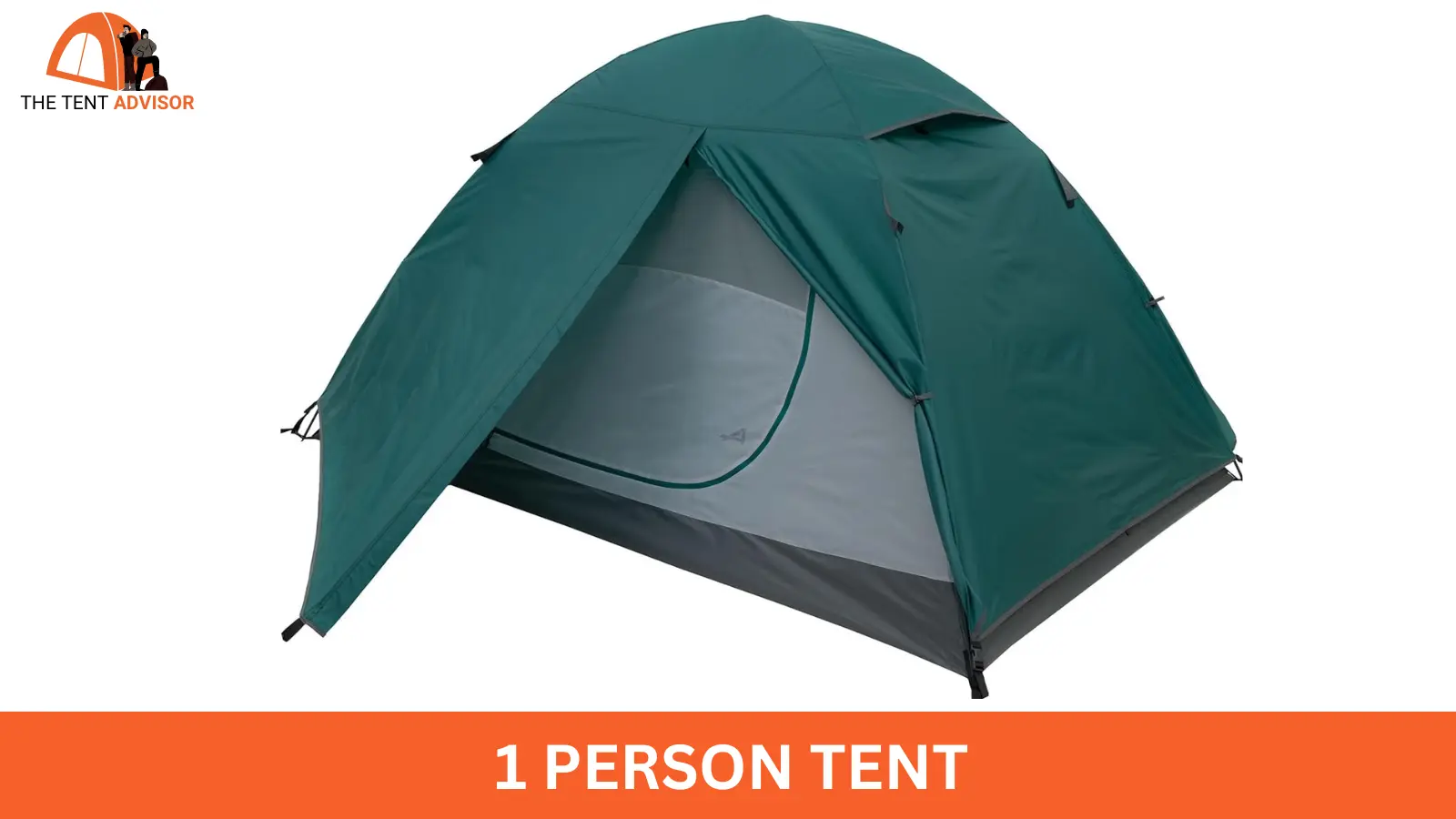
A single-man tent is excellent for individual campers, backpackers, or hikers. Its floor space usually lies between 15 and 20 square feet, with a widest point of about 35 to 40 inches. This tent is ordinarily streamlined and may be fixed to a knapsack, providing an easy and comfortable resting place. It is advisable to put your gear in the vestibule for convenience inside.
Pro Tip: Attach your gear outside the tent or use vestibules to maximize internal space.
Read full review of camping tent for one person.
Two Men Tent
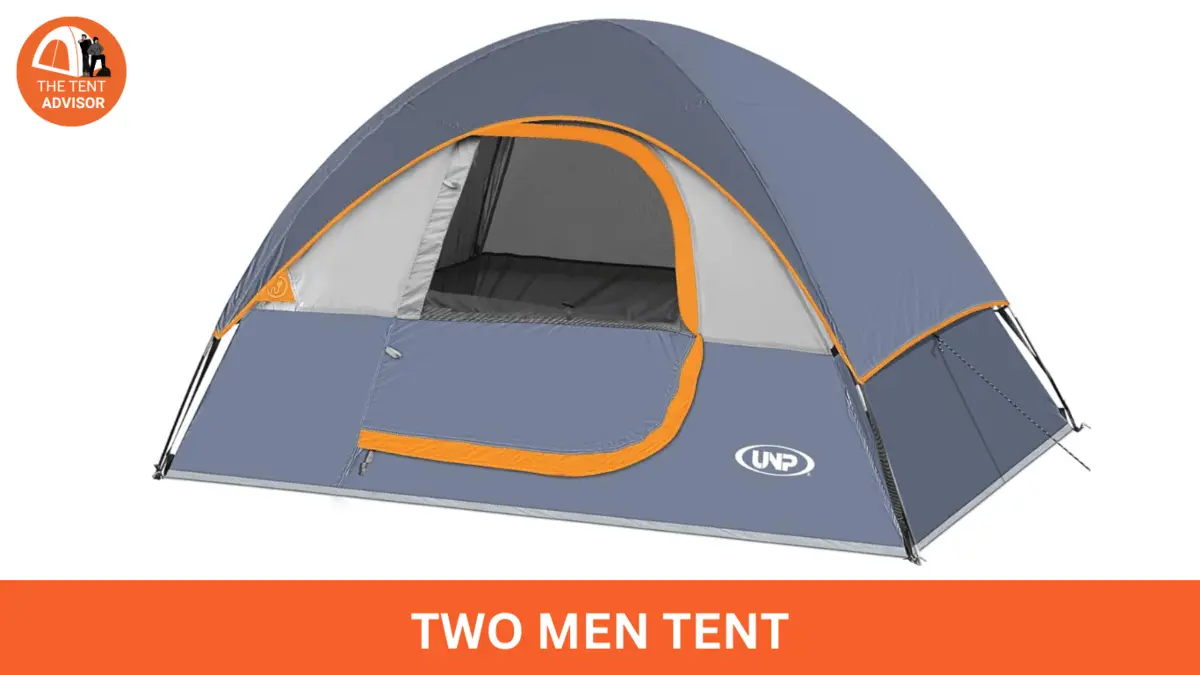
It provides enough room for one person and their gear, but it can be tight for two adults. The average floor area varies from around 30 to 35 square feet. A two-person tent is the most significant piece of camping equipment you’d want fastened onto your backpack while still being able to stroll easily at your campsite.
Three Men Tent
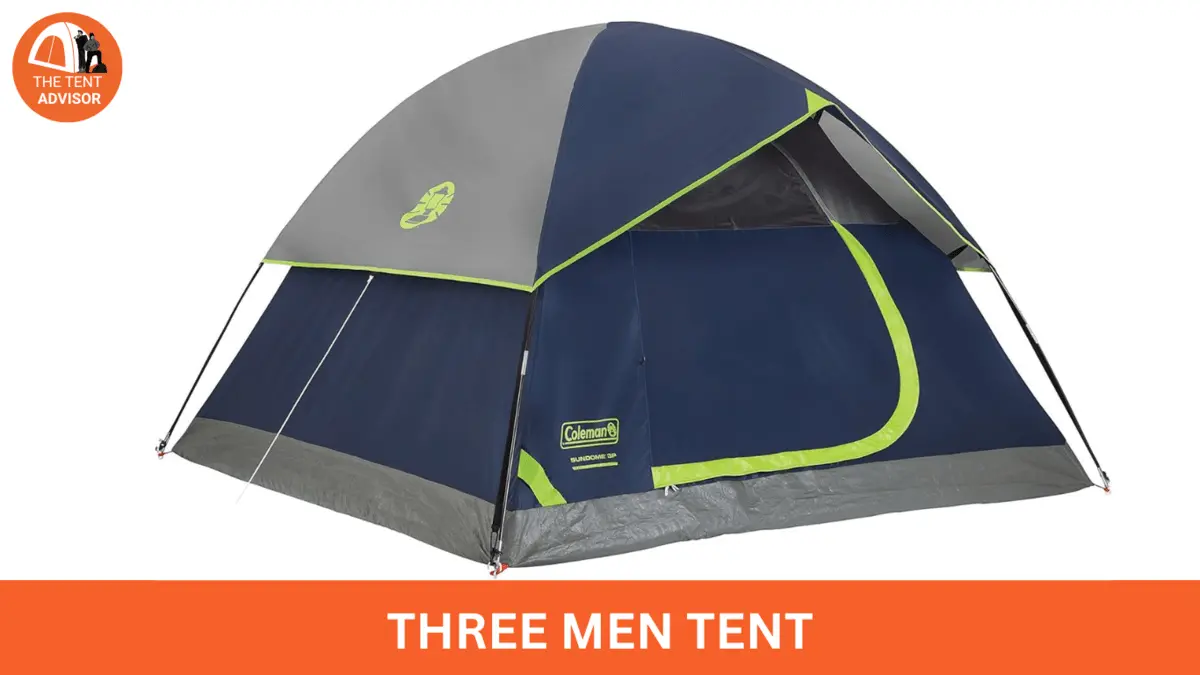
This kind may accommodate two people comfortably and leave space for movement. It would also house a small child or a family dog. The floor area ranges between forty and forty five square feet on average. For hiking it is better if one person carries the main body while another carries the poles and other accessories.
Pro Tip: Choose a tent with a larger vestibule and more than one entrance point so that dealing with loads becomes much easier.
Four Men Tent
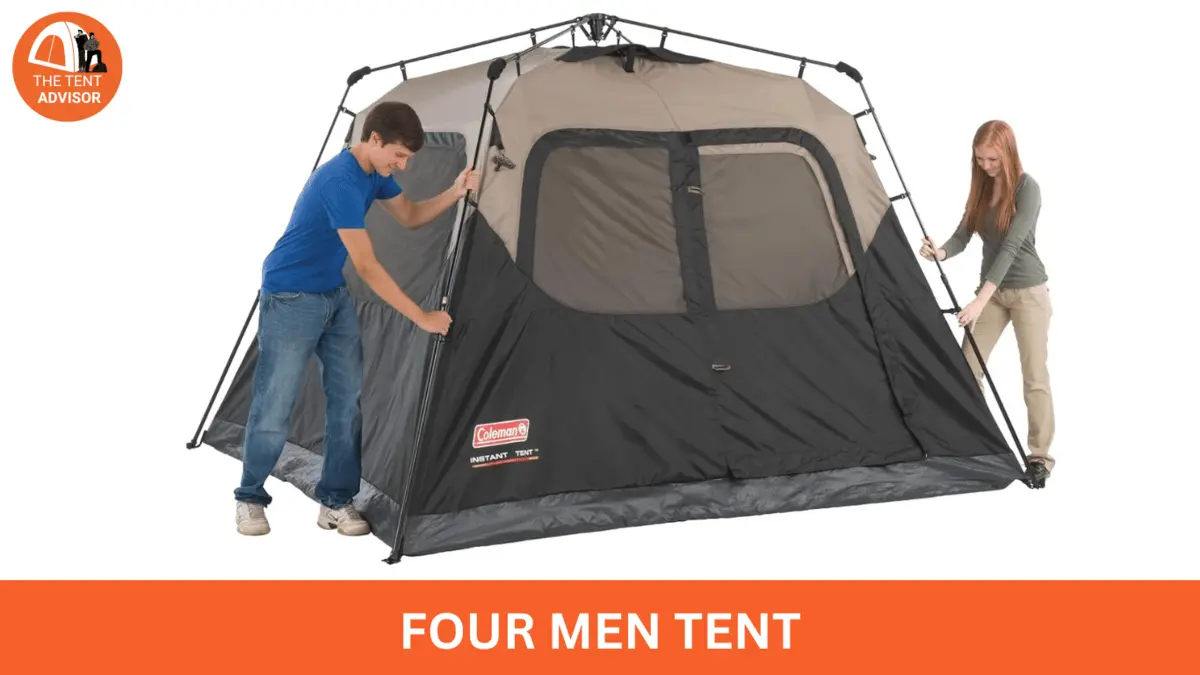
The smallest family tents are often regarded as four-man-sized ones; however, they do not work perfectly for more than three people plus their gear.
These have an average floor area of sixty to seventy square feet each, making them the most popular size because they provide a snug fit for three grownups, together with that small kid or domesticated non-speaking pet.
Five Men Tent
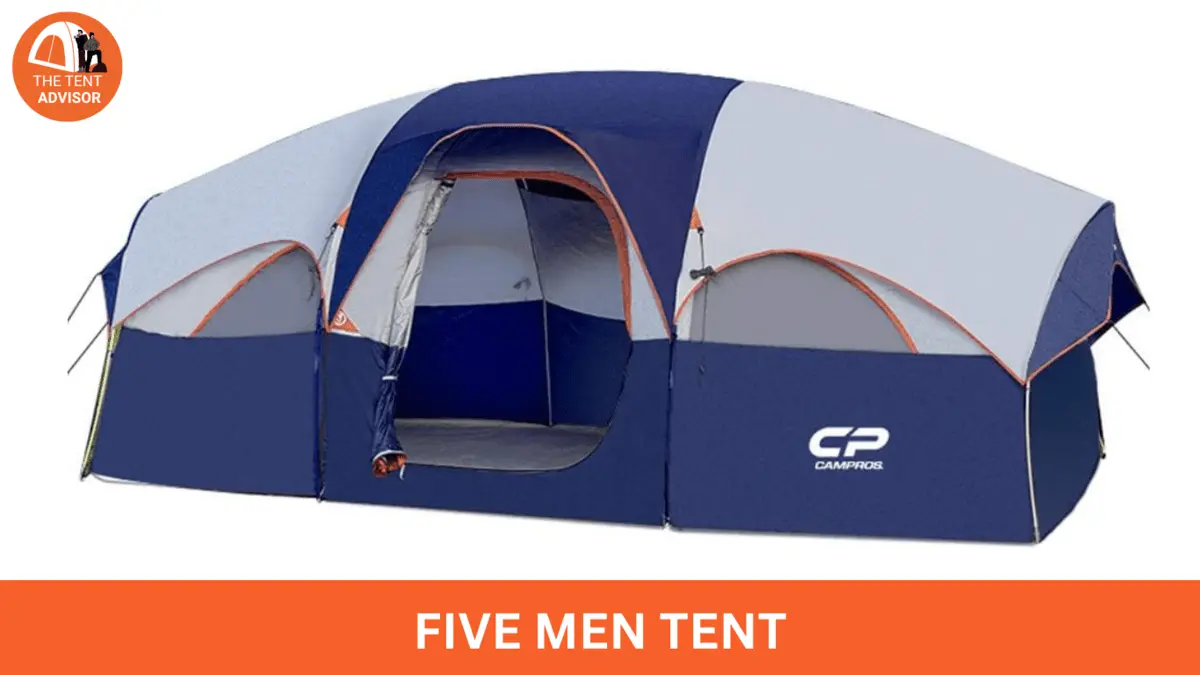
A five-man-sized tent perfectly accommodates four people but could be cramped for five. Such tents have spacious floors, usually between seventy-five and eighty square feet. At this point, the head height becomes high enough for adults to stand tall inside.
Six Men Tent
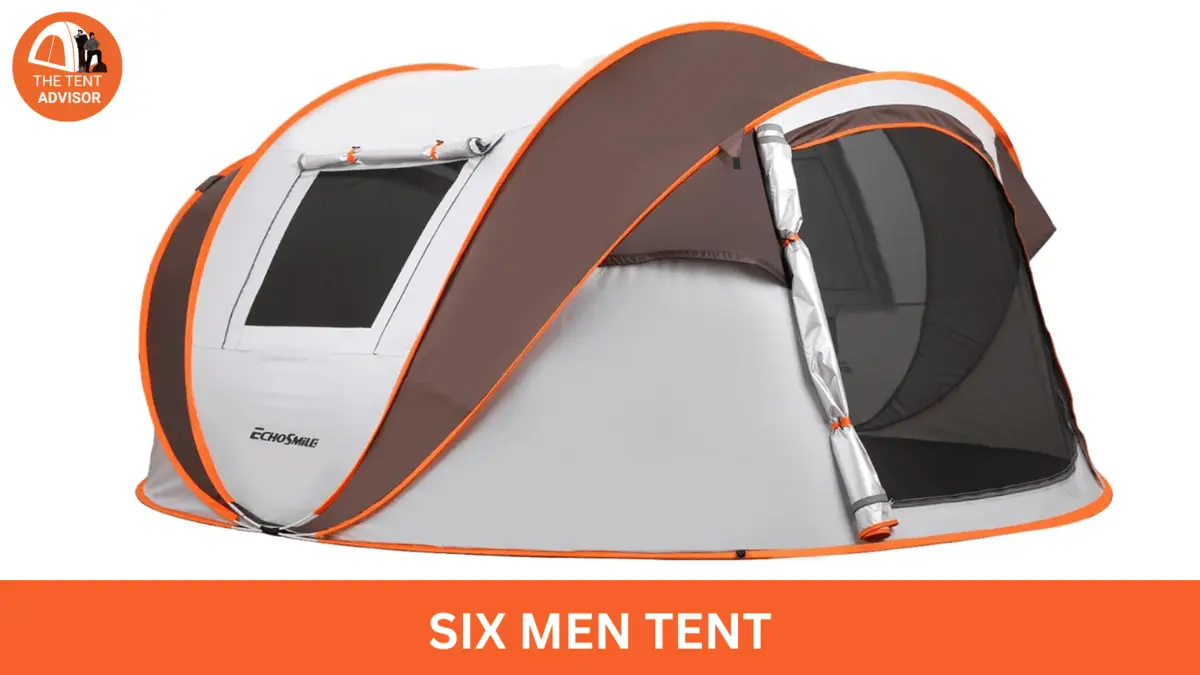
This is the most popular size among camping families who have two grown ups and two kids plus their backpacks. Four people plus their gears will fit in comfortably while beyond that it would be tight. The average floor area stands at 90-100 sq ft.
Eight Men Tent
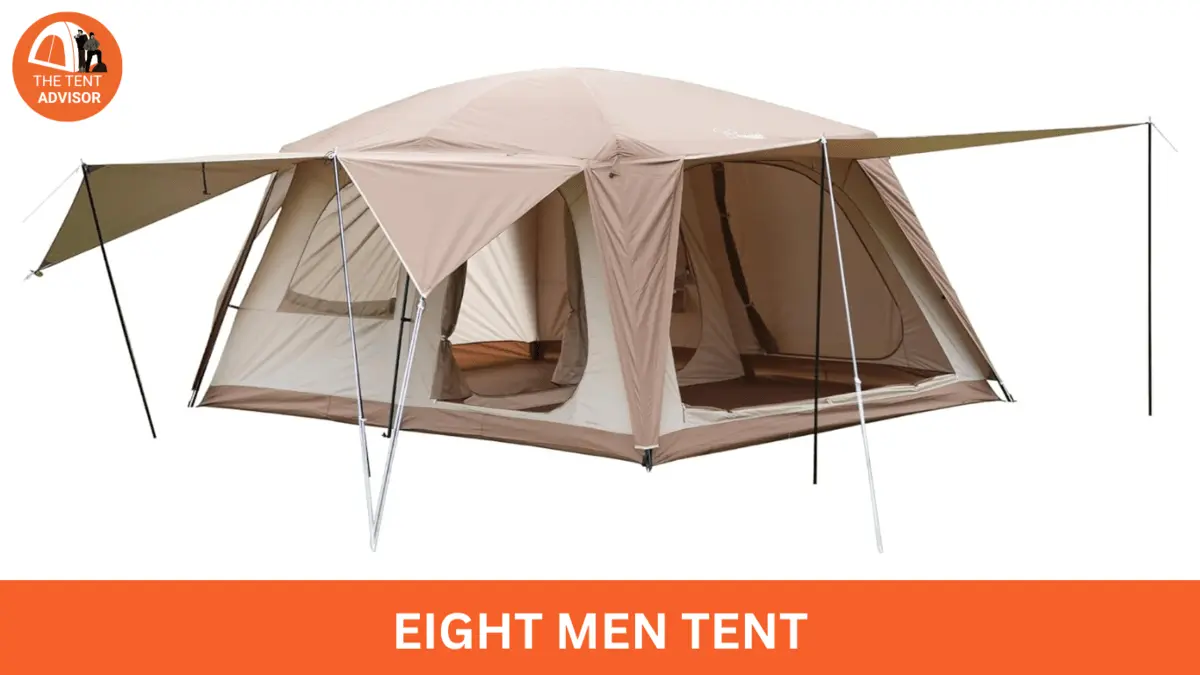
Regardless of whether some are children or dogs, an eight-person shelter can easily accommodate a king-size living section for four guys and provide six others with sleeping space. The floor space varies from 120 to 130 sq ft. On choosing this size ensure that your campsite meets fire distance before placing both down.
Ten Person Tent
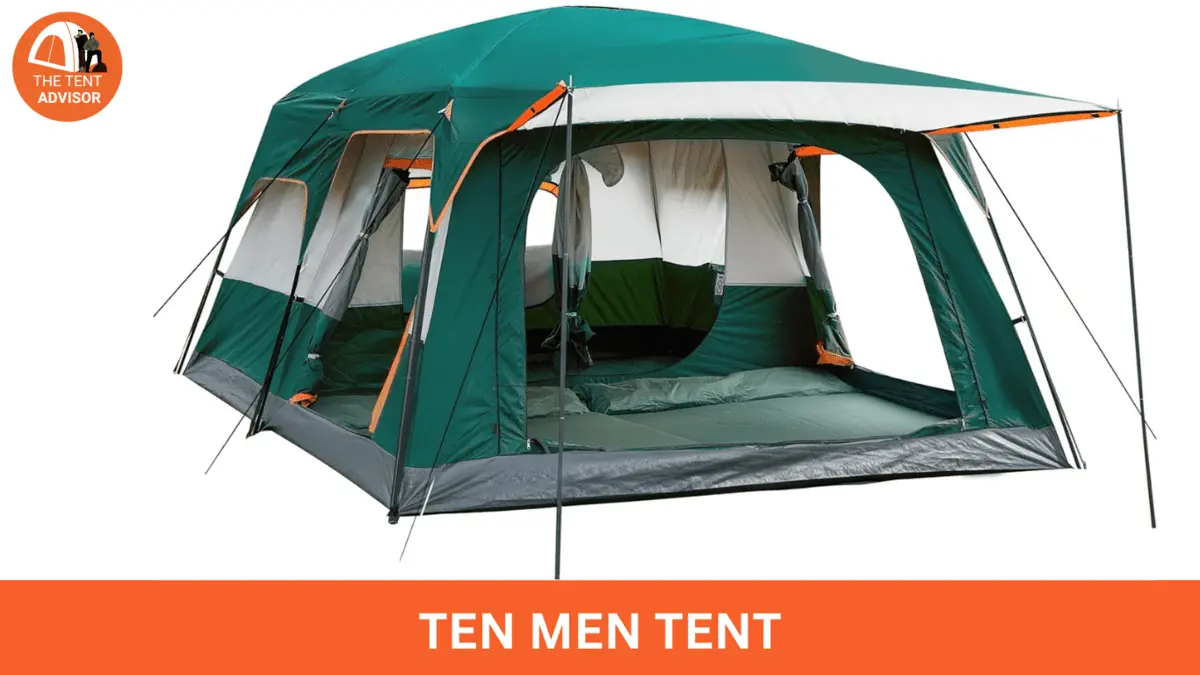
This tent size is among the largest and can easily accommodate four grownups and their belongings with enough excess space for movement. Six adults and some belongings may stay inside it comfortably, but more than that may feel squeezed.
The floor area starts at 150 sq feet to 180 sq feet. Always check if your campsite has any spots big enough for such a large tent.
Pro Tip: If you spend much time inside the tent, choose one with extra headroom or a slightly larger floor area.
Tent Size Guide:
Use this guide to determine the appropriate tent size for your group:
2 people – 9’ x 9’ tents
3 persons – 9’ x 11’ tents
4 persons – 10’ x 12’ tents
5 people – 10’ x 12 tents 6
man tent-9 ft by15 ft
Material Recommendations:
Nylon: although nylon works well as flooring material and is light and durable, it’s not ideal for making walls. It is not breathable, becomes hot and stuffy, and does not resist abrasion as much as other materials do.
Fiberglass: this type of material is best suited for window/door screening since it is sturdy and lasts long.
Considering these factors when choosing the appropriate material and size, you can ensure that camping will be a comfortable and enjoyable experience for all family members.
Types of tent
Wall Tent
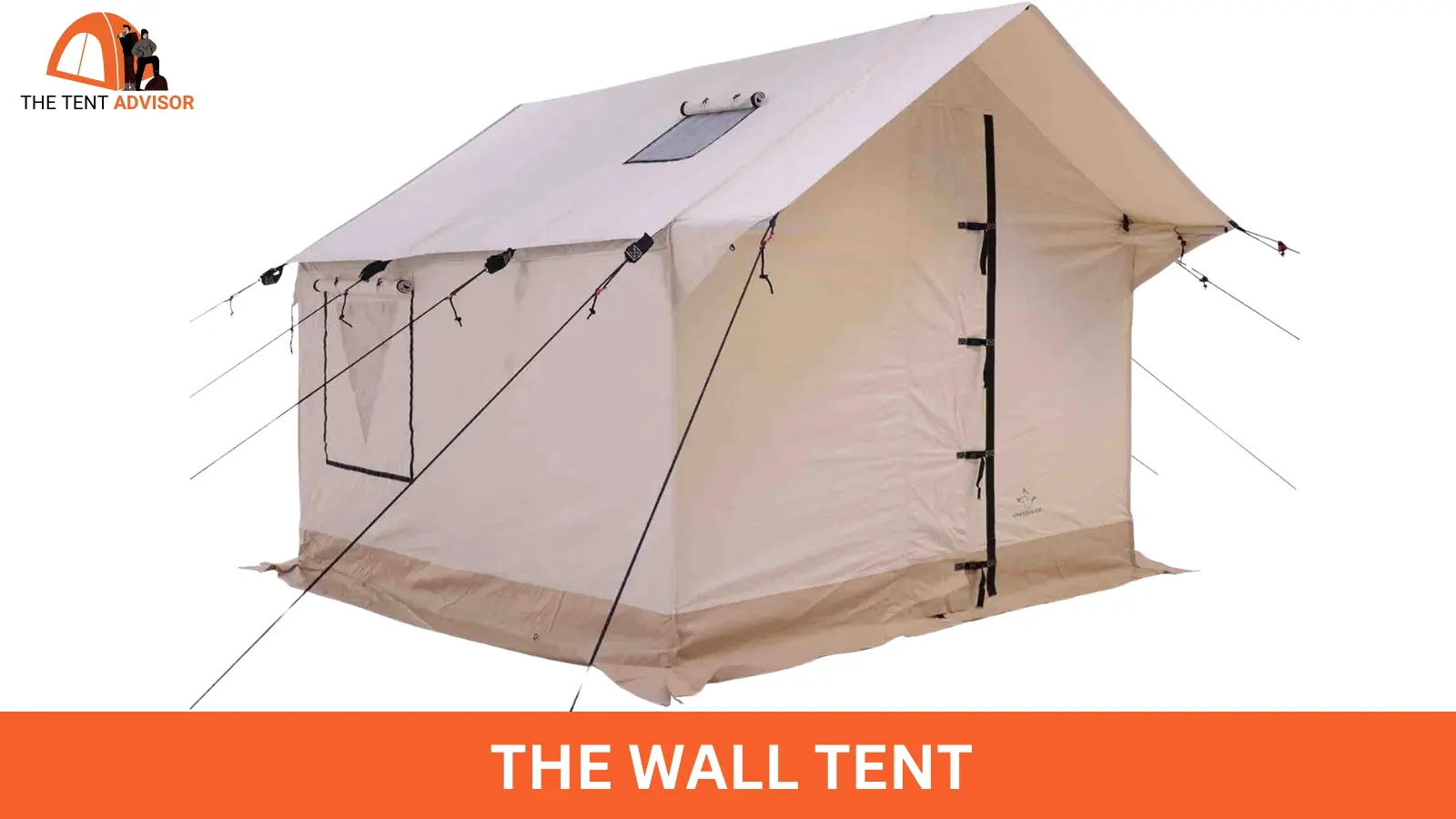
Though wall tents are preferred for extended stays over short trips due to their heavy weight and large size, they are essential. It is available in different sizes, like 9×11 feet, with a cost ranging between $60-$130, or even bigger ones, like 16×20 feet, which must be ordered specially.
This makes it provide maximum usable space without getting any obstructions from the centre pole. Its ridge height of 7-7.5 ft offers enough headroom. Nevertheless, this feature of its being heavyweight and cumbersome may give it a hard time when setting up and moving around.
The bungalow tent
is also called “cottage” tent and is best suited for long summer camps offering huge space as well as enabling division of rooms inside it unlike other tents.
These are usually about 9×12 feet wide and weigh almost 100 pounds going at no less than $100 each. The roomy design makes extended camping more comfortable while its overall size and pitching requirements imply that there is a lot of time needed during preparations.
Now, under adventurers comes the explorer tent, which can withstand such harsh climatic conditions as wind, snow, rain, etc. It costs nearly $200, but some drawbacks include being heavy and costly and offering a tiny floor area, making it unsuitable for family camping.
A pup tent

is another option for two campers, which has been associated with camping for many years. Its dimensions are roughly 5×7 feet with a height of 3.5 feet, and prices range from $10 to $20 each. It may seem cheap enough or suitable for kids or even storage only, yet its basic form does not guarantee comfort.
The umbrella tent: With a quick setup that touring campers love so much, measuring around 9×11 feet, retailing at an average price range between $90 -$140.
Have outside aluminium framing, hence more usable floor space and the possibility of adding extra rooms. On the other hand, this has poor ventilation; it sways on solid winds, and its high sides often make it susceptible to storm damage.
The baker tent costs between $40 and $180 and looks like a reflector oven with an open front for a fire. Although it is suitable for cold seasons as it can be warmed by heat from the inside, not everybody likes using it, so it is not a common one for families.
Wedge tents, or “A” tents, have sharply sloping walls ranging from 7×7 to 16×20 feet, costing between $40 and $170. These are easy to put up but have extra space or storage, although if things touch the walls, water may seep through due to their sloping design.
The tropical tent
A variation of bungalow tents, has net-screened sides for better air circulation. It measures up to 7.5×10 feet, selling at a maximum price of about $450, giving excellent air circulation; however, this is too expensive and has excessive air entrainment such that most families would not require this.
This popularity is attributed to the fact that one person can quickly erect it, and its simplicity and sturdiness are highly regarded. Additionally, these are light, thus making them movable easily without guy ropes except during bad weather, yet they deprive you of headroom, too.
To get more about popup tents, read our guide on Are-pop-up-tents-good?
Tips on Choosing a Tent
Family tent shopping is effortless, but it’s worth considering that different families have different needs and wants. Here are some points to help you:
Kind of Camping: The type of camping influences the tent you need. One can choose a bigger and heavier tent when travelling with a small trailer or by car. If you plan to hike or travel in canoes, a lighter tent will be needed.
Tent Materials:
Tent materials vary in weight. Generally, they fall into three categories:
Drill: Unmentioned but another standard fabric among tents.
Duck: This is actually cotton which has a high thread count; it can last; and it resists harsh temperatures; it also weighs moderately (7 – 9 oz per sq yrd) and has tightly woven square weaves.
Poplin: Made from fine-combed yarn, poplin is sturdy and has a smooth texture that makes it suitable for quality tents.
Nylon: Although nylon does not mildew, lightness becomes less important as campers discover that nylon may not last long enough. Nylon loses elasticity with time, crumbles away at the touch, and breathes far worse than canvas. A nylon tent may be hot inside.
Choosing the suitable material and size will ensure a comfortable camping experience.
Care of the Tent:
Keep Tent in Good Order: In one season, an uncared for tent can be destroyed; with good care, it can last 25 years.
Storage: Never store a wet or damp tent to prevent mildew, which rots the fabric.
Cleaning: Clean grease and dirt spots with mild soap and a brush before storage.
Tent Accessories:
Rope: For tie-downs, sisal rope is preferred over clothesline rope. However, nylon or polyethylene ropes are longer lasting.
Pegs: Wooden pegs can be made at home or camp, while metal pegs are more accessible and can be driven into hard ground.
Tent Runners: Used on all guy ropes for easy adjustment, especially after rain.
Read more about Camping tent accessories here
Tarpaulins: Useful for ground cloths, extra shelter, windbreaks, or covering items.
Awning: Provides added protection and improves ventilation.
For more advice read on Best Tent Camping Checklist for Families-2024
How to Pitch a Tent:
Preparation: Choose a level and smooth camp spot. Try setting up the tent at home first.
Steps: A tent’s bottom part must be stretched by putting flags in its corners while erecting poles and fastening guy lines.
Final Check: The canvas should look neat and smooth, and all four corners should meet at right angles. Do not stretch too tight.
Following these guidelines will help you choose the right tent and ensure it lasts for many camping trips. If you want to know in details read this article
Choosing the right size tent for camping- Final Words
When choosing the right size tent for camping, the number of people who will utilize it should be the first thing to think about. In many cases, going for a larger tent can mean more convenience. When determining the size, remember to pay attention to materials, season ratings, and what it may cost. For various budgets and group sizes, see Tentadvisor, with its wide range of tents that would suit your camping needs.
https://krex.k-state.edu/server/api/core/bitstreams/458d625b-5d74-4e37-ace2-24423549e1e3/content
